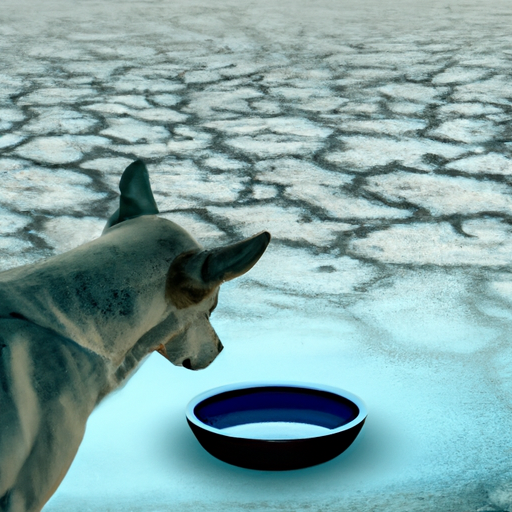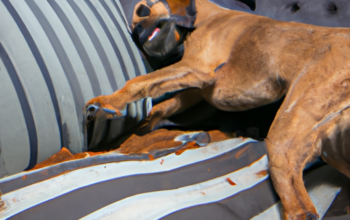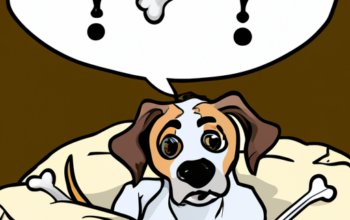You’re a pet parent, so you know that water is crucial for your dog’s overall well-being. Just like humans, dogs are primarily made up of water; it constitutes about 60 to 80% of their body weight. Water isn’t just the fuel that keeps the tail wagging, it’s also essential for most of their bodily functions – from digestion and absorption to maintaining body temperature and lubricating joints.
Understanding how long your furry friend can go without this precious resource is key to keeping them healthy and happy.
While there’s no one-size-fits-all answer to this question as various factors come into play, generally speaking, a dog can survive around two-three days without water. However, this does not mean they should be made to do so. Dehydration in canines can set in quickly and may lead to serious health issues if not addressed promptly.
Throughout this article, we’ll delve into the importance of hydration for your pet, signs of dehydration to look out for, and tips on keeping your beloved pooch hydrated at all times.
Importance of Hydration for Canines
Ever wondered why your furry friend’s water bowl empties so quickly? Well, it’s because staying hydrated is absolutely crucial for their health and wellbeing! Canine water intake is not just about quenching thirst; it supports a myriad of vital bodily functions.
It aids in digestion, absorption of nutrients, circulation of blood, transportation of oxygen to cells, and helps maintain body temperature. Moreover, proper hydration helps flush out toxins and waste from the body, which boosts their immune system.
Hydration health benefits extend beyond these basic needs too. When your dog is well-hydrated, you’ll notice that their skin is more elastic and healthier looking – an easy way to tell if they’re drinking enough or not. Plus, staying hydrated can help prevent kidney stones and urinary tract infections in dogs.
So next time you see your pup lapping up water like there’s no tomorrow, remember this: keeping them constantly topped up with fresh H2O isn’t just a good idea—it’s essential for their overall health!
Factors Influencing a Dog’s Need for Water
Your pup’s hydration needs can be impacted by numerous factors such as their size, diet, and activity level.
Larger dogs tend to require more water than smaller ones because of their larger body mass and metabolic rate.
Also, the type of food your canine companion eats plays a crucial role in their hydration status.
Dogs fed with wet food may require less water compared to those on a dry kibble diet since wet food contains approximately 70-80% moisture.
Active dogs also need more water than sedentary ones due to increased loss of fluids through panting and sweating from their paw pads during physical activities.
Breed Specific Hydration is another factor that comes into play when determining your dog’s watering needs.
Some breeds are adapted to arid regions and naturally consume less water while others bred for cooler climates might need more water intake.
Similarly, Seasonal Water Requirements vary for dogs just as they do for humans; during hotter months, dogs will drink more because they lose more fluids trying to cool down through panting.
On the contrary, in colder seasons when they’re not exerting themselves as much or fighting off heat, they might drink less frequently but still it’s important not to neglect their hydration needs regardless of the season.
Signs of Dehydration in Your Pet
Spotting signs of dehydration in your furry friend can be tricky, as they might not always show obvious symptoms.
Let’s imagine a scenario where you’ve taken Bella, your Golden Retriever, for a summer hike. If Bella starts panting excessively and seems lethargic after the hike, she may be dehydrated – these are some common signs to watch out for.
Other Dehydration Symptoms may include dry nose and gums, loss of appetite or skin elasticity that doesn’t spring back when pinched.
Here is a breakdown of three key indicators to keep an eye on:
-
Excessive panting or drooling: Dogs cool themselves down by panting. However, if Bella pants more than usual after physical exertion or exposure to heat without sufficient water intake, it could indicate dehydration.
-
Loss of energy or lethargy: A sudden change in your pet’s behavior such as seeming tired or less enthusiastic about activities they usually enjoy should raise a flag.
-
Changes in their eyes: Sunken eyes can also be an indication of severe dehydration.
In case you notice any of these symptoms in Bella, it’s time to take action! Emergency Care should involve providing her with fresh cool water immediately but don’t let her drink too quickly, which can cause vomiting, making the situation worse. Also, consider seeking immediate veterinary attention as severe dehydration can lead to serious health complications if left untreated.
Tips for Keeping Your Dog Hydrated
Keeping Bella hydrated, especially during a scorching summer hike, means you’ll need to pack plenty of cool fresh water and take regular drink breaks.
If fresh water isn’t readily available, consider bringing along some dog-friendly water alternatives like canine sports drinks or hydration products designed specifically for dogs. These are often enriched with essential nutrients and electrolytes that help maintain your furry friend’s hydration levels. Just remember though, these shouldn’t replace water but serve as a supplement when needed.
While on the go, ensure that you have portable bowls or specially designed pet bottles to make it easier for Bella to lap up her drink. It’s also crucial to recognize when she needs a break; if she starts panting heavily or slows down significantly, then it might be time for a quick rest and rehydration session.
You can also keep her hydrated by offering foods with high water content like cucumbers or melons as treats in between activities. Hydration products such as wet food or hydrating gels can further aid in maintaining optimal fluid balance in your pet’s system.
Stay vigilant and proactive about keeping Bella well-hydrated; doing so will help ensure she remains healthy and active even under the sunniest skies!
What to Do if Your Dog isn’t Drinking
Imagine, for a moment, that Bella turns her nose up at the water bowl you’ve carefully filled; it’s an alarming sight indeed, and one that demands immediate attention. You might not know this, but your dog’s water preferences play a significant role in their hydration level. For example, some dogs prefer cold water while others might like it room temperature. If Bella consistently ignores her water dish, try changing the temperature of the water or even the dish itself. Some dogs are sensitive to metallic dishes and may prefer ceramic or plastic ones.
Moreover, encouraging fluid intake in other ways can help keep Bella hydrated if she isn’t drinking enough plain water. Consider adding wet food to her diet which has high moisture content or make a homemade broth (without salt or seasoning) and pour it over her dry food. Another option is to invest in a pet fountain as many dogs are enticed by flowing water rather than stagnant bowls. Below is a quick table with some ideas:
| Ways to Encourage Fluid Intake | Description |
|---|---|
| Change Water Temperature | Some dogs have preferences about their drinking water’s temperature – experiment with both cold and room-temperature options |
| Use Different Dishes | Try using different types of dishes like ceramic or plastic instead of metal if Bella seems hesitant |
| Add Wet Food or Broth | Including wet food in Bella’s diet or pouring homemade broth over dry kibbles can increase her fluid intake |
Remember: each dog is unique so what works for one might not work for another – be patient and consistent until you figure out what works best for your furry friend.
Frequently Asked Questions
How does a dog’s age impact their water intake requirements?
A puppy’s hydration needs are higher due to their active nature. As your dog ages, these needs decrease but remain crucial. Monitoring hydration indicators like skin elasticity can help ensure they’re adequately hydrated.
Can certain dog breeds go longer without water than others?
Like camels crossing a desert, some dog breeds indeed have unique hydration traits that let them go longer without water due to their climate adaptation. However, it’s crucial to keep all dogs well hydrated for health reasons.
What are some common diseases in dogs that could cause them to drink more or less water?
Kidney disease and diabetes in dogs often increase water consumption, while illnesses like Parvovirus may cause decreased drinking. If you notice such symptoms, seek veterinary interventions to ensure your pet’s proper hydration and health.
What are the effects of dehydration on a dog’s behavior and energy levels?
Just like a parched traveler in the desert, your dog’s dehydration symptoms can affect behavior and energy. They may become lethargic, disoriented or anxious. Hydration remedies include fresh water access and electrolyte-rich solutions promptly.
How does a change in the dog’s diet impact their need for water?
Changes in your dog’s diet can significantly impact their hydration needs. High salt foods increase thirst, while water-absorbing foods like rice can reduce it. Always consider dietary hydration when adjusting your pup’s meals.
Conclusion
Imagine your pup as a brave explorer, traversing the wild savannah under the blazing sun. Without those vital oases – water dishes and hydrating snacks – they’d soon wilt under the heat.
Just like you need regular pit stops on an adventurous journey, so does your furry friend.
Don’t let your dog’s adventure turn into a perilous trek. Keep their hydration levels topped up, monitor for signs of dehydration, and ensure they always have access to fresh water. It’s not just about quenching thirst; it’s about keeping them healthy and ready for life’s next big expedition!



